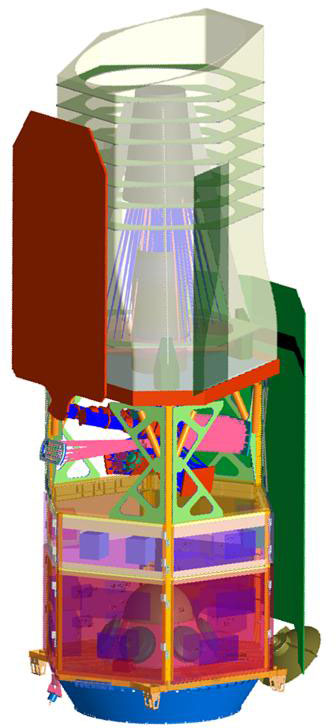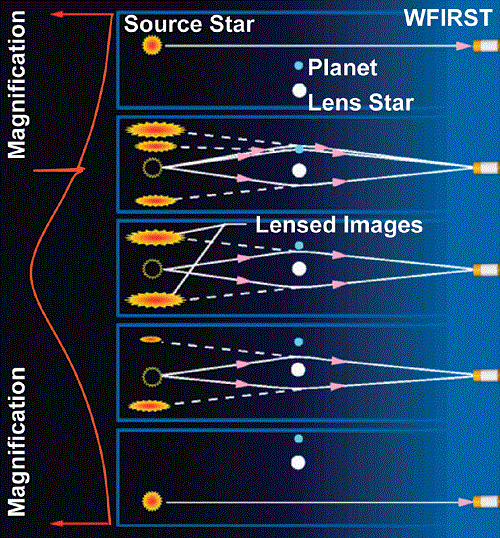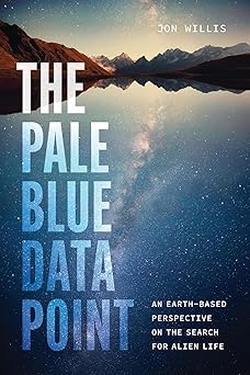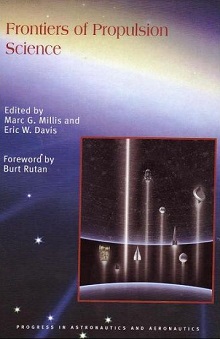
Thinking as we have been about exoplanet detection, and in particular about taking the next steps beyond the James Webb Space Telescope, I’m intrigued to see what has happened with the WFIRST mission. After all, despite the successes of Kepler and ESA’s CoRoT, we live in an era when mission cancellation is not uncommon. The Space Interferometry Mission was canceled outright, while Terrestrial Planet Finder, long touted as the way we would home in on nearby planets like our own, has been put into indefinite suspension. The JWST is on the horizon, but interesting new possibilities are now bubbling up around WFIRST, the Wide Field Infrared Survey Telescope. A mission with a dark energy pedigree could now have serious exoplanet implications.
In Exoplanet Capabilities of WFIRST-2.4, Philip Horzempa looks at the latest design to emerge for this mission, one that takes us much deeper into exoplanet country than I had thought the mission could. After all, WFIRST was conceived as a way of studying dark energy and the universe at the largest scale, using what had been 1.2-meter optics. But Horzempa points out that the National Reconnaissance Office (NRO) has now given NASA two Hubble-class 2.4-meter telescope mirrors, a gift that will boost the mission’s capabilities dramatically.
Image: As envisaged by the Astro2010 Decadal Study, WFIRST will be a wide-field-of-view near-infrared-imaging and low-resolution-spectroscopy space telescope. WFIRST will address two of the most fundamental questions in astrophysics: Why is the expansion rate of the universe accelerating? And are there other solar systems like ours, with worlds like Earth? Credit: NASA GSFC.
Evolution of a Mission
My recent post on using gravitational lensing to search for planets around Proxima Centauri reminded me that microlensing was folded into WFIRST from the start, but boosting the optics with a 2.4-meter mirror means that three times as much light will be collectable by the space observatory. The WFIRST exoplanet program centers on 500 days of observation time spread over five years, observing a set of adjacent fields in the galactic bulge. The information thus gathered, because it is not weighted (like radial velocity methods) to large, close-in planets, will help us understand more about solar system structure around a wide variety of stars.
The Science Definition Team commissioned by NASA to study the enhanced WFIRST design talks about finding in the range of 300 Earth-mass planets and 40 Mars-sized worlds using microlensing, with as many as 1000 super-Earths also likely to be found, for a grand total of perhaps 3000 exoplanets of all kinds emerging from the mission. Moreover, these methods would allow WFIRST to detect orphan planets ejected from their solar systems, galactic wanderers we are unable to detect with other methods. These worlds would be interesting not only in themselves but also as statistical fodder for planet formation theories.

Image: A microlensing light curve (left) produced by the relative movement of a star-planet system with respect to a background source (right). Image Credit: Dave Bennett (Notre Dame).
WFIRST’s continual evolution is also leading to the addition of a coronagraph that can block out the light of a central star to make it possible to image the planets around that star directly. So now we’re talking about a plan that, unlike Kepler, can go to work on the closest planets to our own system. Perhaps hundreds of new worlds could emerge from this work, all of them relatively nearby (the thinking in the current WFIRST report from the Science Definition Team is to look at the brightest 200 stars within 30 parsecs with these methods). Terrestrial worlds are beyond the capabilities of a WFIRST-2.4 coronagraph, but Neptunes and Jupiters should be well within its reach.
And here we come to one of the main points I wanted to make with this post, keying off Lee Billings’ concerns, discussed yesterday, about how and when we would start to get exoplanet spectra for worlds in the habitable zone. WFIRST can’t manage that feat, but it’s a step in the right direction. From Horzempa’s article:
The new WFIRST telescope will be also be able to obtain spectra of those planets, telling us something about their nature. As mentioned above, this will be the next crucial step in exoplanet exploration. We now know something about the sizes and masses of exoplanets. However, knowledge of surface composition is sorely lacking. Spectra obtained by WFIRST will help remedy this. Then, scientists will have data to help answer the questions raised by these worlds. Are they rocky planets? Gas giants? Are they ocean worlds? Are they covered in clouds? Are they worlds with compositions not found in our solar system? Some of the top targets for WFIRST will be the exoplanets discovered by the ground-based Doppler method. It will be able to confirm their existence, as well as tell us something about their personalities.
Current thinking is that WFIRST would be placed in a geosynchronous orbit, for reasons explained in the SDT report:
The primary factor that drove the selection of this orbit is the ability to continuously downlink data to the ground and obtain a much higher science data rate. The SDT weighed these benefits against the higher radiation environment and slightly less stable thermal environment versus the Sun-Earth L2 orbit chosen by the previous WFIRST SDT.
Servicing issues are also an obvious benefit of GEO. But a geosynchronous orbit rules out the use of a starshade, which may be the most potent way to block starlight and thus explore the habitable zone around target stars. There continues to be talk of using a starshade with the James Webb instrument and later missions, but it’s unlikely that WFIRST will one day be moved into position at L2 after fulfilling its earlier mission at GEO, as Horzempa suggests. Even so, WFIRST at GEO would still be able to home in on Kepler discoveries, along with whatever the Transiting Exoplanet Survey Satellite (TESS) comes up with.
Recovering Lost Mission Capabilities
A great deal of work was expended in the Terrestrial Planet Finder days to develop our coronagraph technology. So will that work now turn around to feed into WFIRST-2.4? For that matter, asks Horzempa, can WFIRST recover some of what we lost with the cancellation of the Space Interferometry Mission? The right technology could make this happen:
This could be accomplished by an ingenious method of adding a grid of micro-dots to the primary mirror. As with the other mechanical obstructions in the optical path, these dots would not interfere with images formed by the telescope. However, those dots would produce diffraction spikes that would serve as a tool for astrometry: measuring, with exquisite detail, the positions and motions of stars. What it translates to in practice is a powerful exoplanet discovery method for WFIRST-2.4. The astrometric dots would allow the telescope to measure the masses of exoplanets, even those that do not exhibit TTVs [Transit Timing Variations].
Astrometry is a powerful tool, one that could deepen our understanding of the Kepler discoveries, conceivably detecting non-transiting planets around some of these stars. Will such an astrometry option make its way into the final WFIRST design? If so, we could say a little bit of the SIM mission survives.
A fully enhanced WFIRST opens up other exoplanet possibilities as well. Adding the larger mirror would mean that WFIRST could detect TTVs several times smaller than Kepler. That should get the attention of David Kipping (Harvard-Smithsonian Center for Astrophysics), whose continuing work on exomoons relies partly on the precise detection of these kinds of variations. Could it be that WFIRST will detect our first exomoon, conceivably a large world orbiting a gas giant?
So at least one path forward after the James Webb Space Telescope begins to become apparent, in the form of a WFIRST mission enhanced with larger mirror and coronagraph and, perhaps, the grid of micro-dots discussed above. Is this the final precursor to the terrestrial planet imager we’re aiming for, the observatory capable of taking those critical spectra in the search for biosignatures? It might be if NASA decides to proceed with the WFIRST-2.4 design, a decision that should take place this month before further SDT meetings in September.
The Science Definition Team’s final report is “Wide-Field InfraRed Survey Telescope – Astrophysics Focused Telescope Assets,” available online.



“The primary factor that drove the selection of this orbit is the ability to continuously downlink data to the ground and obtain a much higher science data rate”.
That’s good because when it stops working correctly, it’s toast, no matter how many billions are spent on it.
If these projects can get funding, I am all for them. I share the concerns of a comment yesterday that pointed out the 2o plus year lag between proposal and launch, even when funding is provided. I will never live to see this thing, short of having my consciousness “downloaded” into a functioning android.
But I won’t be on the warp-starship either, and I am all for it’s developement.
Talking about how great the data will be from these wonderful telescopes assumes that they will make it safely to their stations and then work perfectly for a long time.
So by all means, let the science go forward, it’s fabulous. But the guys with wrenches and parts have to be able to get to these telescopes. I hope they will at least design it so that it could be worked on in case someday the Chinese might loan us one of their ships. Getting out to a geo-sync orbit to do that would be more demanding than LEO.
I operate very amazing flying machines that soar miles in the air. They are quite reliable as they are built upon the lessons of over 70 years of observing what can go wrong. But even then, if they were not returned constantly to the wrench-turners, they wouldn’t be aloft for very long.
Yet that is the approach we are taking with astronomy. OK, call me Kepler-stressed.
I hope that NASA does put a starshade on the James Webb instrument. If they did would it be powerful enough to detect the major gases in the atmosphere of an Earth or Super Earth sized planet with spectroscopy? If it can I hope that the starshade moves beyond talk into reality.
SWEET telescope graphic!
Do dark energy and dark matter demand new physics? e.g. does it have a wavelength? I have tried and fail to understand what the popular science press says except that it explains the missing mass.
Also, what is the math comparing how many hubble/jwst/kepler type scopes we could have for the cost of the ISS/Shuttle programs?
” the addition of a coronagraph ” YAY!!!!!
Make it so!
Paul W, I completely agree with you. I have built an entire career around mission and safety critical embedded systems, but for all the advances of the last 25 years they are toast if the wrong components fail.
In space as on earth, you will never be able to beat the flexibility,problem solving ability, and sheer creativeness of an evolved ape with a spanner & screwdriver.
It seems likely though that developing and maintaining a human space-repair capability would cost more than the missions it’d be repairing. Making the missions as reliable as possible (and doing as much science as we can from the ground) are the probably the only workable solutions.
These plans for one of the NRO OTAs makes so much sense that surely NASA will find a way to kill it! The extra-galactic bullies also surely won’t like more exoplanet science (and telescope time) that these plans call for. Same goes with a starshade to be used with JWST, I’m afraid. An Explorer class starshade mission (maybe with the OTHER NRO OTA?) would get more science done, probably.
http://news.yahoo.com/survey-hunt-nearby-alien-planets-cheap-140546654.html
I am behind the curve with this comment, and no one will likely see it, but the above link is along the lines that I think we need to move in.
Putting ultra expensive planet finders in space is wonderful technology and I am all for it if the funding can be found. But launching these scopes takes decades, and then when they break after just a few years or sooner, nothing can be done.
If exo-planets can be found with earth-based technology, I have to vote for it. When something breaks on one of these survey telescopes, the techs can march right up there to the site and fix it, and the project continues.
The Hubble people had the right idea, place it where it can be worked on. They had the advantage of the shuttle, and it’s a good thing, as the Hubble was flawed and unusable upon arrival in LEO.
Another Exoplanet Hunting Mission Ends: CoRoT Spacecraft Can’t be Recovered
by Nancy Atkinson on June 26, 2013
More bad news on the exoplanet-hunting front: While the final fate of the Kepler spacecraft remains unknown, the CoRoT (Convection, Rotation and Planetary Transits) satellite has now been officially shut down.
CoRoT suffered a computer failure on November, 2, 2012 and although the spacecraft is capable of receiving navigational commands, the French Space Agency CNES reports it can no longer retrieve data from its 30-centimeter telescope.
After a valiant effort to try and restore the computer, CNES announced this week that the spacecraft has been retired. CoRoT’s journey will come to a fiery end as it will be deorbited and it will burn up on re-entry in Earth’s atmosphere.
While it’s always hard to see the end of successful mission, we can’t be too sad about CoRoT, however. The mission lasted twice as long as expected and it gathered a remarkable haul of exoplanets. CoRoT looked for planetary transits — a dimming in brightness of the host star as a planet crossed in front. CoRoT was the first mission to find a planet using the transit method.
In all, CoRoT has spotted 32 confirmed planets and at least 100 more are awaiting confirmation. The mission also allowed astronomers to study the stellar physics and the interior of stars.
Full article here:
http://www.universetoday.com/103163/another-exoplanet-hunting-mission-ends-corot-spacecraft-cant-be-recovered/
To quote:
CoRoT was also the first to obtain measurements of the radius of brown dwarves, intermediate objects between a planet and a star, and literally opened up a whole new field of study of temporal analysis of the micro-variability of stars by measuring the frequencies and amplitudes of stellar vibrations with unprecedented precision.